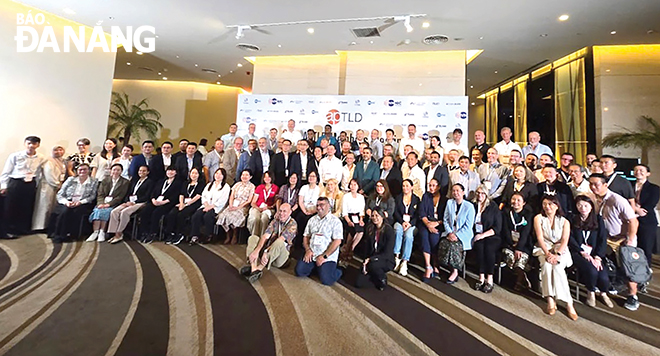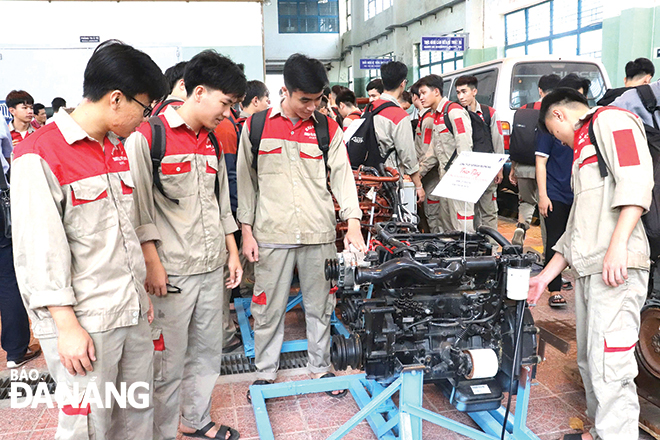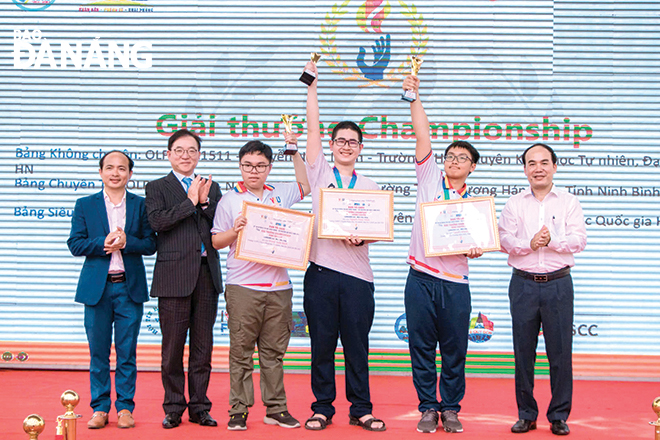'Global Talent' and opportunities for Da Nang
Rapid technology development, population aging and global labour migration trends and increasingly fierce competition for human resources make the global talent shortage more complicated. It not only causes negative impacts on economic growth and labour productivity but also leads to fierce competition between countries. What should Viet Nam, and Da Nang in particular, do to take advantage of this opportunity?
 |
| The Asian IT conference in Da Nang attracted many young talents to discuss and share regional and global issues, bringing valuable opportunities to Da Nang. Photo: TRAN VAN NAM |
Why is there a shortage of talent?
In recent years, many countries have implemented ‘Global Talent’ attraction programmes to promote economic and technological development, especially the US, Australia and Japan with scholarships to study abroad, work visas or settlement programmes for those who meet the prescribed conditions in priority development areas such as resources, high-tech agricultural technology, energy, healthcare, digital technology, information technology (IT), semiconductors, infrastructure, financial services and education.
Why is there a shortage of talent?
Firstly, Industry 4.0 (the Fourth Industrial Revolution), promotes the development of new technologies such as artificial intelligence (AI), big data, blockchain, digital technology, internet of things (IoT), cybersecurity and automation. Businesses need human resources with high digital skills, while the education and training system cannot keep up with this demand. Digital transformation in industries such as finance, healthcare, and manufacturing also increases pressure on human resources.
According to a recent study by Randstad, 66 million jobs have been created in 15 countries over the past decade (Randstad is a multinational human resources company with 3,161 global branches, 618,730 employees, headquartered in the Netherlands). Of these, 14.6 million required a secondary education or higher. In reality, due to the lack of training to meet the growing demand, the skills gap is further created, many positions requiring digital skills cannot find suitable candidates, leading to a shortage of talent.
On the other hand, workers need to learn new skills to avoid falling behind, but this process takes a lot of time and resources. The labour market is fragmented, causing some industries to explode in demand (IT, AI, semiconductor chips), while many traditional industries are replaced or reduced in terms of their role.
Secondly, the aging population rate in developed countries. Japan, Germany, Italy, and more recently South Korea and China have had low birth rates for decades and high life expectancies, leading to rapidly aging populations.
For example, in Japan, about 28% of its population is over the age of 65 (as reported in 2023), the highest rate in the world. Meanwhile, the low birth rate (1.3 children per woman) is not enough to offset the shrinking workforce. The total birth rate is now below the replacement rate - the level needed to maintain a stable population.
According to a 2024 Manpower Group survey, 75% of global employers are having difficulty in filling vacancies. Clearly, fewer people are working, while the cost of caring for a growing number of elderly people is putting a heavy strain on economic systems, slowing growth and innovation around the world. Employers are increasingly struggling to find qualified candidates. Due to the shortage of highly qualified labour, developed countries are forced to depend on human resources originating from developing countries, but this cannot completely resolve the problem.
Thirdly, due to economic disparities and better opportunities, the attractive policies of attracting talents of developed countries and the globalization of the international labour market that allows talents to easily work in other countries.
 |
| Students of the University of Science and Technology practice on modern equipment. Photo: NGOC HA |
Opportunities for Da Nang
Viet Nam has many advantages to attract and develop Global Talent, especially as globalization and digital transformation trends continue to grow for the time being. Viet Nam has a young population, with more than 50% of the population of working age. The workforce is dynamic, willing to learn and adapt quickly to new technologies. The rate of young people accessing higher education and vocational training is increasing, especially in STEM (science, technology, engineering and mathematics) fields.
Labour, living and operating costs in Viet Nam are lower than many other countries in the region, creating attractive conditions for international companies and talented people who want to develop their careers or invest here.
Viet Nam is becoming an emerging technology hub in the ASEAN region, with the emergence of many startups and research and development (R&D) centres of large corporations such as Samsung, Intel, LG and Google. Major cities such as Ha Noi, Ho Chi Minh City and Da Nang invest much in technology, digital transformation and digital infrastructure, thus creating a ideal and favourable environment for international experts.
Da Nang is centrally located on the North-South axis of Viet Nam, a dynamic city, an important gateway connecting the Central Viet Nam and Central Highlands cities and provinces with the East Sea. Da Nang includes coastal plains, hills, rivers and peninsulas such as Son Tra, creating conditions for multi-sector development such as tourism, logistics and industry. Da Nang has convenient transportation including an international airport, deep-water seaports, railways, roads and highways.
Da Nang has a hi-tech, IT and industrial parks, together attracting domestic and foreign investment in high-tech industries such as software production, electronics, and biotechnology, and serving as centres for research and innovation development. Da Nang is known as the “city of IT”, with large data centres and advanced technology management systems. E-government and Smart City projects have been successfully implemented, becoming models for other Vietnamese cities and provinces to follow. Internet speed is among the fastest in Viet Nam, suitable for developing technology services and software outsourcing.
Notably, Da Nang has just been approved by the National Assembly to pilot a free trade zone (Resolution No. 136/2024/QH15 of the National Assembly on the organisation of urban government and piloting a number of specific mechanisms and policies for the development of Da Nang) and the Politburo has agreed to the policy of building a regional financial centre in Da Nang.
The city’s education system features public and private colleges and universities in a multidisciplinary and multi-field direction. The University of Da Nang (UD) will become a national university in the near future. Opportunities to develop technology talent through joint programmes implemented very successfully with Japan (Unitech, Shinko Technos, Takemoto Denki, NAL Solutions, NiX Ecucation), South Korea (KOICA), Taiwan (China) (NTUSC, NCKU, NTU, Academia Sinica), the US (UW, PSU, ASU) and Europe (Grenoble, Nice, LMU, Erasmus+) are valuable models.
The governments at all levels in Da Nang have launched startup support policies, tax incentives for high-tech enterprises and smart urban development projects. Da Nang has a healthy living environment, attracting young talent and their families. In addition, policies to upskill, reskill, and redeploy the existing human resources are implemented according to policy mechanisms.
For example, from 1 May 2024, Singaporeans aged 40 years and above receive a SkillsFuture Credit (Mid-Career) top-up to pursue a substantive skills reboot. Da Nang should, therefore, choose 2 to 3 key directions to focus on attracting foreign companies to promote the development of global human resources according to the national government's direction: Fintech and ATP (assembly, testing, and packaging) in semiconductor technology.
In an effort to develop the micro, semiconductor and strategic sectors in line with the city’s orientation, Da Nang needs to develop high-quality human resources through strong investment in STEM education and digital skills. In parallel with that, it is a need to strengthen international cooperation in training and technology transfer, create more favourable settlement policies and multicultural working environment.
Promoting the image of Da Nang as an innovation centre in Viet Nam and building hi-tech zones and creative workspaces (innovation hubs) should also be taken into account.
An extensive new Korn Ferry report finds that by 2030, more than 85 million jobs (equivalent to nearly the population of Germany) could go unfilled because there aren't enough skilled people to take them. The Vietnamese government needs to take the lead in training available talents while smarter organisations are proactively training, improving professional skills and developing talent.
 |
| Candidates participating in the 5th Central Viet Nam - Central Highlands Informatics Olympiad - 2024 organized by the Viet Nam - Korea University of Information Technology and Communications. Photo: NGOC HA |
With its outstanding potential and achievements, with open policies, under the guidance of Resolution No. 169/NQ-CP of the Vietnamese government promulgating the action program to implement Conclusion No. 79-KL/TW of the Politburo on continuing to implement Resolution No. 43-KL/TW of the Politburo (term XII) on building and developing Da Nang by 2030, with a vision toward 2045, Resolution No. 26-NQ/TW of the Politburo on socio-economic development and ensuring national defense and security in the North Central and Central Coast regions by 2030, with a vision toward 2045, Da Nang has the potential to become an attractive destination for students, for university graduates who need advanced training in localities in the region and the whole country, to both contribute to solving the problem of global talent shortage and promote the socio-economic development of Da Nang, and Viet Nam at large. Effective cooperation between government, businesses and educational institutions is in an urgent need to implement the above-mentioned strategies.
Reporting by PROF. TRAN VAN NAM - Translating by A.THU








